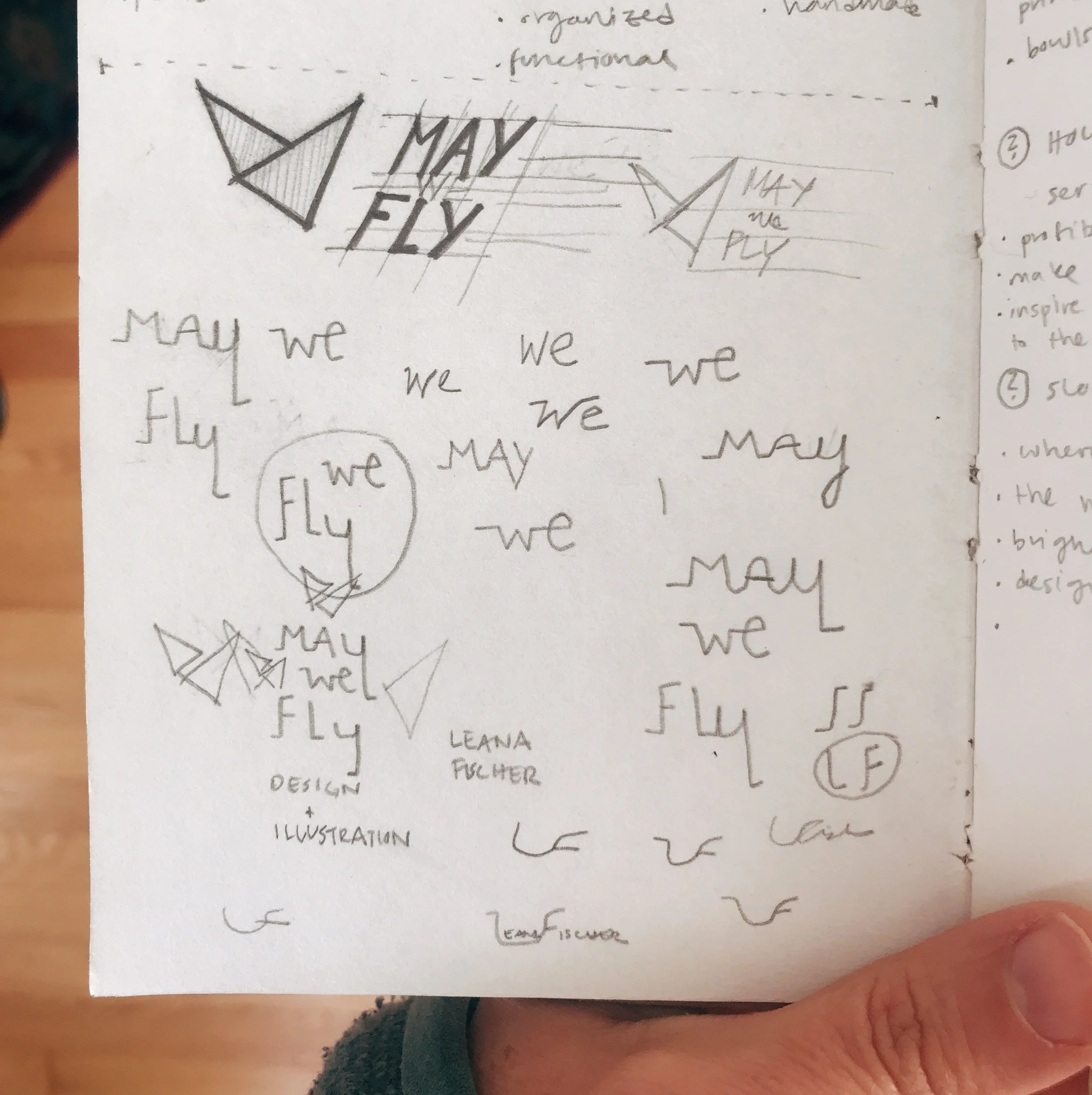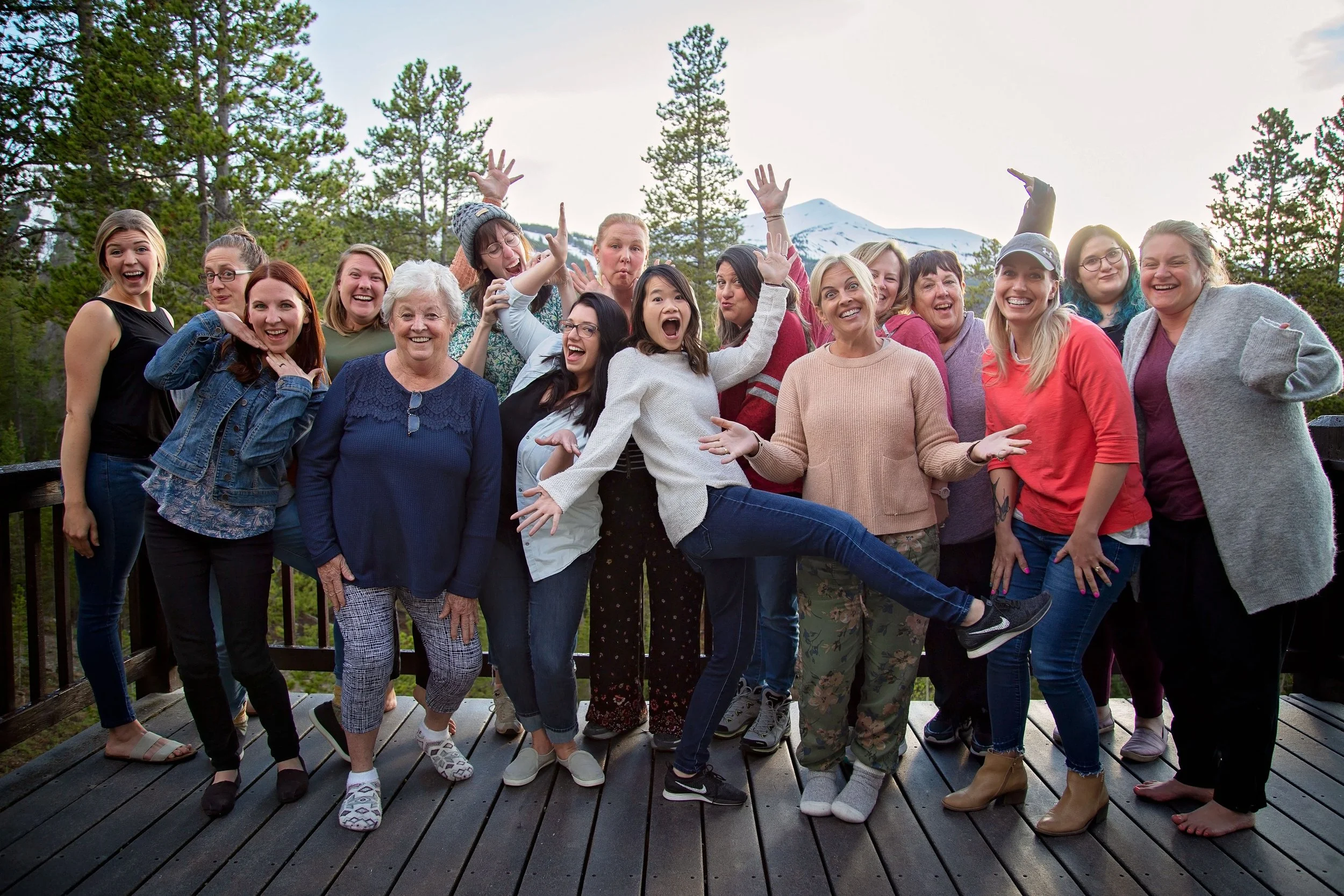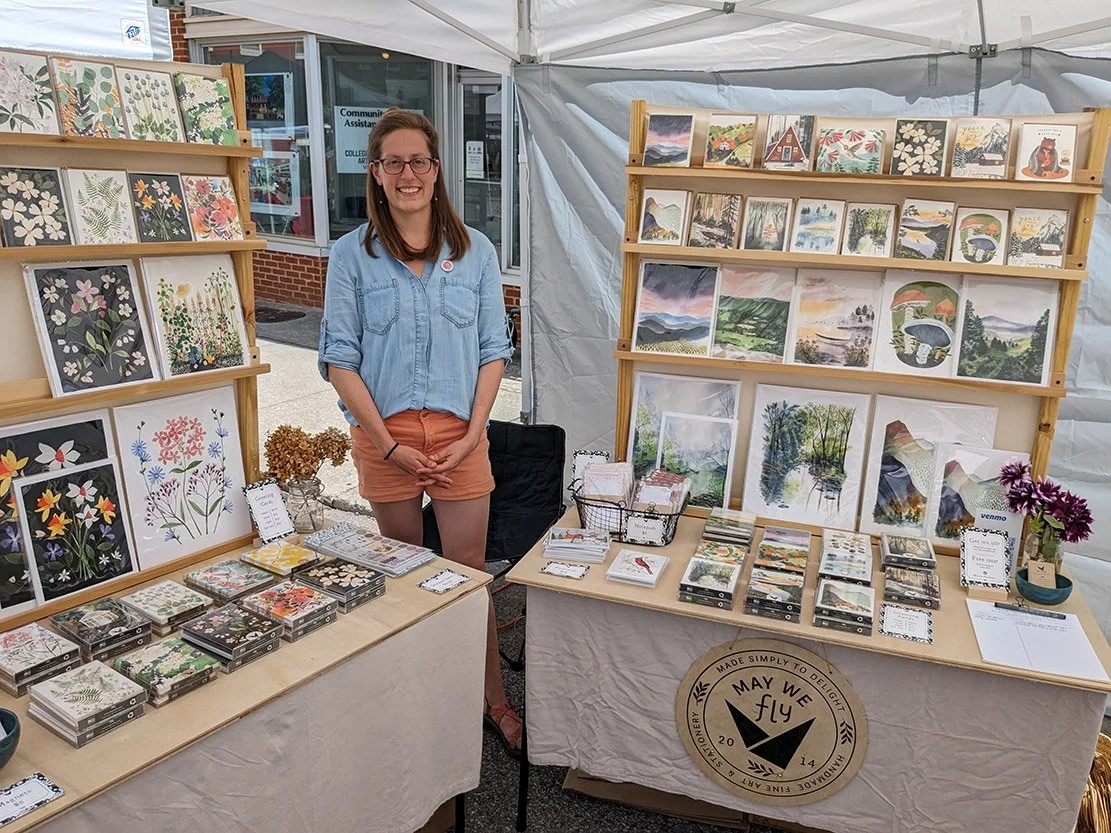Slow Growth Is Best
Ten years ago I was perched on a stool at my painting table in the office I shared with my husband, Dan. This little corner was where I (re)-discovered my love for watercolor painting and started dreaming about what it could look like to start taking it seriously.
Sketches e of logo ideas for an art business I wanted to start called May We Fly.
My first paint palettes
I had already been creating artwork for about a year and selling it a little bit here and there. But I consider November of 2014 the “official” start of my art business because that was when I walked myself over to the bank with a check for $250 and opened an account under the name May We Fly.
Like anyone looking back at themselves after a decade, it’s obvious to see how much I didn’t know. After all, the story was just beginning! But what I did know was that making artwork was my soul’s work, and I was ready to jump in with both feet.
There’s so much more I could tell about those early years (you can read more about some of that here), but instead I’d like to share about some of the lessons I’ve learned along the way.
1 - Develop a life vision, and then try to work backwards
Knowing what you’re working towards is key to maintaining focus and momentum.
In my earliest days, I knew that building a creative business was what I longed to do, but there was so much else about my life as a whole that I hadn’t yet developed a vision for. This led to a lot of trial and error (lots of error), and my business pursuits taking up too much of my mental and physical energy.
Of course, the many failed pursuits helped me to clarify what I actually wanted, but had I taken time to visualize goals for my life as a whole, I might have avoided at least some of the failures and built a business that aligned with the larger picture of my life more quickly.
I have a document I’ve written called a “Rule of Life” that lays out my core values along with tangible ways to actually live them out. I refer to it and modify it regularly, especially when I feel I’ve gotten off course in some way. It’s really helped me keep my business and life in alignment and stay focused, especially during seasons that feel uncertain or unpredictable.
→ Helpful resource: “Create Your Rule of Life” course by Tsh Oxenreider
2 - Put the artwork first
There is simply no substitute for putting in the time at the painting desk. This is where the magic really happens, even when it’s hard to see progress day to day. It can be very tempting to try and start monetizing right away, especially when you know that you’re ready to turn your art practice into a career. But, creating strong, genuine artwork is the key to eventually making money from it.
I know how hard it can be to actually make art regularly. Life is so full, and many of us start out our creative pursuits in the margins between work, family, etc. The key for me was (and still is) to schedule actual time for it in my weekly calendar, even if only 30 minutes a day. Of course, I’ve gone through seasons where even this amount wasn’t possible (hello early parenthood), but it’s so much easier to maintain momentum than to pick it back up again.
Something that really helped me early on was participating in a creative challenge called “The 100 Day Project.” By committing to the project and telling others about it, I was able to actually make art (almost) every day during the 100 days, which in turn made it easier to simply keep going in the days thereafter. I also grew a lot in my painting ability and honed in more on my style.
If there’s anything I can point to that has actually made my creative career possible, it’s the investment of time I’ve given to my art practice from the beginning.
Which leads me to my next lesson…
3 -Don't try to do it all at once
In the past I have been (and still sometimes am) very easily distracted by “shiny objects,” revenue streams that look exciting to pursue as an artist. Indeed, there are many possibilities out there (licensing, wholesale, print on demand, teaching…), but I made the mistake of trying to develop more of these than I could realistically handle at one time. As a result, my art practice suffered and I was stretched way too thin.
The sustainable path towards growth, at least for me, has been to slow down and stay focused on what is actually working, adding more as time and energy allows.
→ Helpful resource: “The One Thing” book by Gary W. Keller
4 -Get clear on what the work is about
It’s so natural to look out there, see what is working for others, and make art that is similar in the hopes that it will catch the same wave of success. Whenever I’ve been tempted to do this, it’s led to me feeling frantic and out of touch with my own work.
Yes, it’s good to have a pulse on what people are looking for, but as an artist, the most essential thing is to develop your own voice and know why you make art in the first place. It takes time to cultivate a distinctive style, but starting with the “why” behind it all is the first big step towards getting there.
5 - Define success
For too long I saw success as an artist purely from a financial standpoint, like being able to do it as my full time career or reach a certain revenue goal.
As I became more clear on my life vision and saw how my business fit into that (rather than the other way around), my definition of success became more holistic and refined.
Now, my definition is simply: to live aligned with my values and bless others with my creative gifts.
My key values are:
Freedom in time and resources
Beauty and harmony in my exterior and interior world
Health in body and spirit
Generosity
Connection with friends, family, and community
And I’ve identified my creative gifts as:
Creativity - A desire to make my world more ordered and beautiful
Craftsmanship- Skillful ability to create artwork that others find beautiful
Teaching - Encouraging others with patience and gently helping them step into their own gifts
So, for me, a successful day (i.e. life) means:
I moved my body and nourished my spirit
I spent quality time with friends and family
I worked with focus on my most important work
I didn’t allow fear to guide my decisions
The money is a beautiful outcome of living life this way, but it comes in time and is not the thing to focus on.
6 - Develop systems
The more practical aspects of running a business did not come naturally to me and took a long time for me to learn. There were literally no systems in place when I was getting started. I was learning as I went and scrappily making my way as I gained more income streams and the business grew.
I finally came to understand the value of taking time to develop systems around each process of running the business, from creating the artwork to packaging and shipping an order. No step is too small to have a process! Of course, I had to learn how to do each of these things before making a system for them. But getting clear and organized about the ins and outs of managing each aspect of the business helped me feel much less chaotic and begin to outsource when I was ready.
→ My favorite organizational tool: Notion
7 - Simplify
When I was in architecture school, something the professor would repeatedly challenge us to do was to “make it smaller,” which almost always led to using the space more efficiently and elegantly.
Far too often I make problems more complicated than they need to be. When I can take a step back, identify the pain points, and strip away everything that isn’t essential, it always leads to a sense of ease and calm.
→ Helpful question: “What would this look like if it were easy?” (an idea from Tim Ferriss).
8 - Learn from (and with) others
Living a creative life is in many ways counter-cultural. It means pursuing dreams and goals that don’t have an obvious path forward. As fun and energizing as it is to live this way, it can also be lonely at times.
I have no doubt that I wouldn’t have gotten where I am today without the support and encouragement of friends and family. I’ve also been incredibly blessed to meet other creatives (in person and online), with whom I could relate about my struggles with and learn from as we pursued our own art careers.
Once I was a few years into running May We Fly and finding that I truly had no idea what I was doing as a business owner, I also benefited greatly from business coaching. This is always going to be an investment, but as someone who didn’t have any training in business prior to running one, I can definitely say that it was worth every penny.
→ Favorite coaching programs: Wandering Aimfully, Leverage Your Art
A fabulous group at a creative retreat I helped lead in Colorado
9 - Notice what is special and beautiful about life and share about it
Marketing is probably the aspect of running a business that I’ve struggled with the most. Being genuine is so important to me, the last thing I want is for people to feel like I’m constantly trying to sell them something or manipulate them into buying my stuff.
Over time, I’ve been able to find a way of sharing about my work that feels good, which is simply to document my world through words and photos and put them out there for others to see. This often, but not always, leads to sharing about my work / products I’m selling, but in a way that feels natural to me.
My favorite way to do this in the form of a newsletter, which I genuinely love to make. My audience there is like an extension of my family, and writing it in the quiet of my studio is just a lovely part of my weekly routine.
Social media, on the other hand, has rarely felt this way to me. I’m very grateful for my community there and for the ways in which I know it’s helped me create a platform for my business. But increasingly, I’ve been less inclined to invest time in it, especially now that my time is much more limited with baby girl at home.
Marketing is obviously essential to running a business people know about. The main thing I’ve tried to do is make sure it always feels like “me.”
→ Favorite newsletter software: Flodesk
10 - Slow growth is best
When I was first getting started and was starry-eyed with all the possibilities, I thought I was ready for all that came with the “successful” business I wanted. Even if I could have handled it all at once, I’m grateful it’s taken ten years to build this business to where it is now. Yes, I’m sure it could have happened much faster if I had understood all of these lessons from the beginning, but I’ve been shaped by every challenge and truly wouldn’t change anything about it.
I still have goals I’m pursuing and growth I want to see in my life and business. There are also still challenges and things I’m learning constantly. But at a decade in, I can see that the beauty truly is found in the process of a life being formed, not in reaching some final destination.
In 2014, if I had known how hard this path would be, I’m not sure I would have ventured onto it.
But in 2024, as I work in my home studio part time while I care for my baby daughter, with an amazing team to ship orders to my beloved customers, I am deeply grateful to my past self for sticking with it, but especially to the many who have believed in May We Fly over the years.
It is “we” who have given it wings.
So grateful I still get to share my work
P.S. - I’m an affiliate for some of the resources I shared and make a small commission if you sign up for them. Thank you! :)




